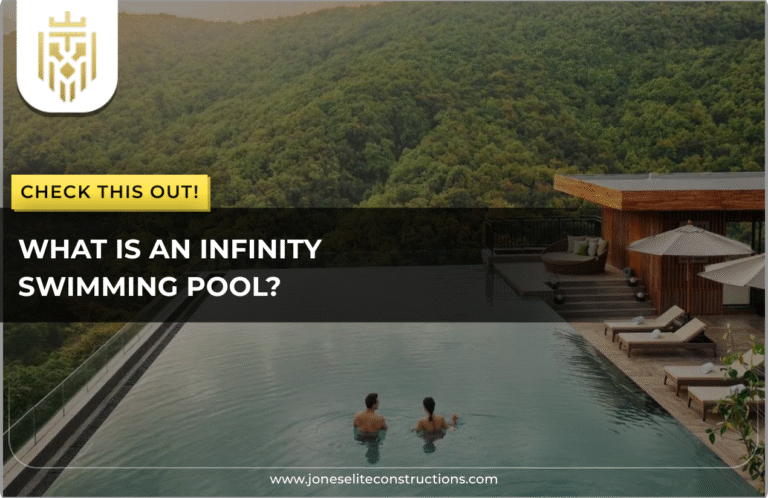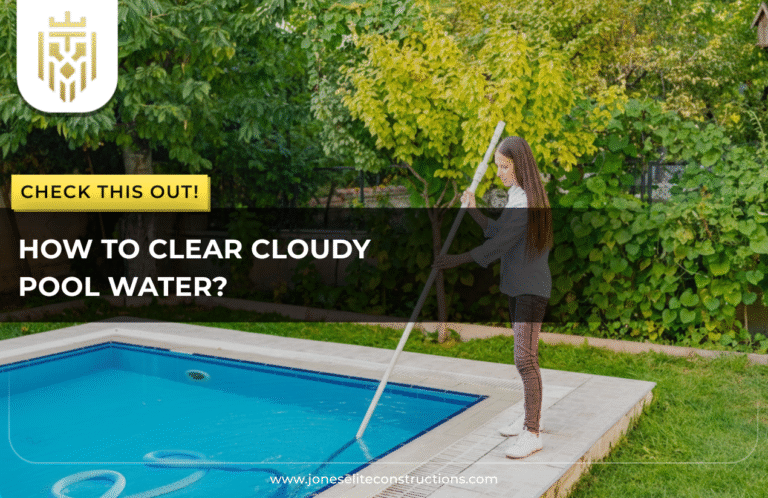Natural Swimming Pool
With human health in mind, parents who are intent on protecting the environment have given it an option for the unacceptable pool-chlorine combination: a natural swimming pool. At its core, it must comply with ecological design principles and present a calm environment where one just feels swimming close to nature, free from harsh chemicals.
What Is a Natural Swimming Pool?
A natural swimming pool mimics a freshwater pond: water is clear, clean, and kept that way via biological filtration. Also known as a bio pool or living pool, often looks like a small backyard swimming pond where the pool environment allows plants and water systems to balance naturally.
How Do Natural Swimming Pools Work?
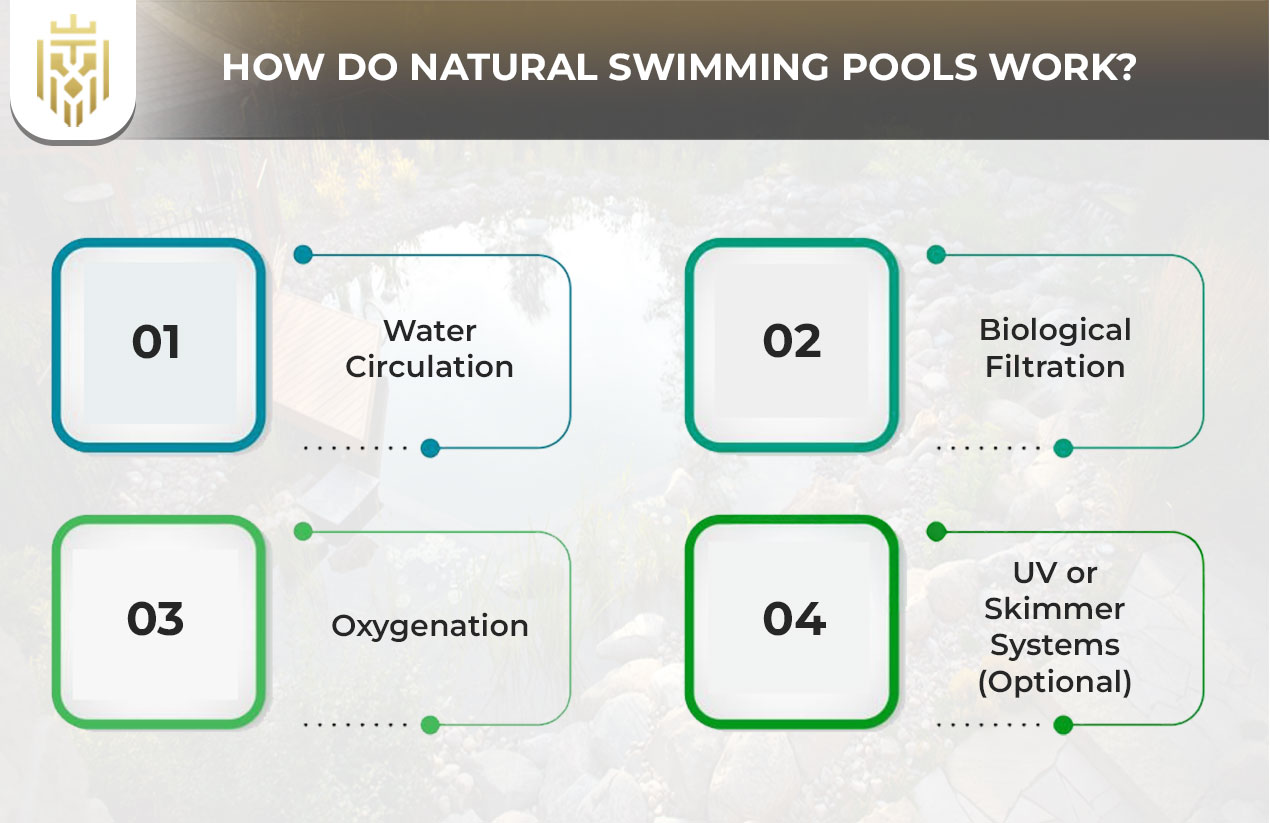
Contrary to normal pools that generally rely on chemical treatment for purification, natural swimming pools utilise a combination of plants, gravel, and filtration zones to keep water clean. This creates a self-balancing pond environment. Homeowners curious about how to build a natural swimming pool should understand its filtration, circulation, and design.
Water Circulation
The healthy natural pool design depends on effective water circulation, carried out by the movement of water between the swimming and regeneration zones. This guarantees that water is never stagnant, providing oxygen and nutrients to filtration plants. This system imitates a genuine flowing pond ecosystem, offering safe and refreshing swimming conditions.
Biological Filtration
Plant filtration is the most important biological cleaning activity. Certain aquatic plants absorb nutrients and block algae from developing, so that the water is clear. The absence of chlorine ensures an enjoyable and sustainable swimming pool experience, for which synthetic treatments need not be continuously applied.
Oxygenation
Oxygenation sustains the pond in ecological balance by supporting beneficial microbes that break down waste naturally. Aeration provided by plants, streams, or waterfalls maintains water clarity. These accommodate keeping your natural swimming pool clean on a yearly basis, healthy, and safe to swim in.
UV or Skimmer Systems (Optional)
Some natural pools may incorporate UV lights or skimmers as optional auxiliary measures to minimise floating debris and pathogens. While not necessary, they do complement the design philosophy of nature-friendly pools, providing additional safety without supplanting biological ones.
Benefits of Natural Swimming Pools

A natural swimming pool has so many benefits: it is safe, sustainable, and visually attractive. Unlike a standard swimming pool, it is a living, breathing pool, breaking away from the hardscape of your garden. It blends fun and nature, turning your backyard into a tranquil refuge.
Chemical-Free Swimming
Of course, having a chemical-free pool can bring good health benefits. Your eyes won’t get red, skin irritation will be a past story, and there are no heavy smells from some chemical being applied. Instead, natural processes like plant filtration and oxygenation purify the water. It leaves a much healthier swimming environment compared to that of conventional swimming pools that are treated with chlorine and salt.
Eco-Friendly
This very fine eco-friendly option of natural systems saves a lot of resources and helps build up biodiversity. It looks like a natural pond swimming pool supporting wildlife, aquatic plants, and microorganisms. This fresh option is pure joy for homeowners looking for sustainability, as it combines health with an environmentally conscious lifestyle.
Less Maintenance
With all its vegetation, water chemistry, and filtration systems working in harmony, the natural swimming pool requires less chemical intervention and fewer water changes. Due to plant filtration and natural cleaning systems, maintenance mainly involves pruning plants and occasional pool inspections, giving the homeowner more time to enjoy their backyard oasis.
Year-Round Enjoyment
The living pool is beautiful and functions during every season, even when not used for swimming. From this perspective, the design and concept of natural swimming pools are a great garden feature that looks somewhat like a pond when not in use. They increase property value while supporting a balanced ecosystem all year round.
Flexible Features
It can look good with waterfalls, stepping stones, or landscaping. Since eco-friendly pool design principles focus on evolution, homeowners may create their own backyard sanctuaries. Whether for relaxation, the view, or recreation, flexible features will fit a person’s needs.
Designing a Natural Swimming Pool
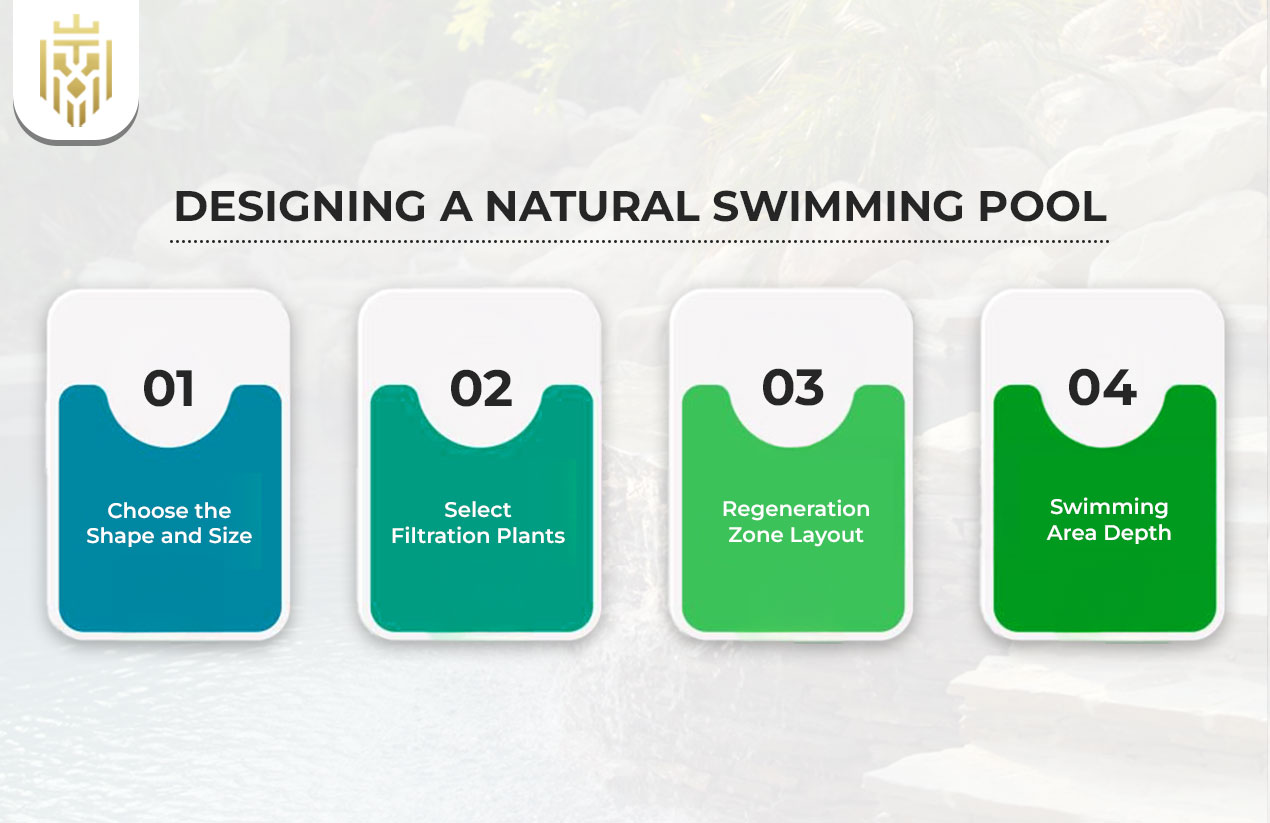
When contemplating how to construct a natural swimming pool, considerations must be focused on its shape, plant zones, and aesthetics. Proper planning shall guarantee the effectiveness of its filtration and balance. A carefully designed natural pool has to marry functionality with beauty to provide an enjoyable swimming and relaxation experience.
Choose the Shape and Size
The size and shape of your natural swimming pool should arise naturally in the backyard. Larger pools allow for diverse plant filtration; smaller pools are easy to maintain. That is to say, be weirdly aesthetic yet support function.
Select Filtration Plants
Plant selection for the regeneration zone is crucial to ensure the appropriate mechanism of plant filtration. Reeds, lilies, and grasses absorbing nutrients separate the algae presence. With good vegetation, your natural swimming pool stays clean, vibrant, and a healthy environment both for swimmers and the wildlife.
Regeneration Zone Layout
Designing the regeneration zone involves the integration of shallow water with aquatic plants. This forms part of what is called a pond ecosystem, in the natural purifying of water. If regeneration is well planned, it can enhance an eco-pool design, and its aesthetics would heighten the pleasing factor of swimming, refreshing, and chemical-free.
Swimming Area Depth
Swimming in a naturally created pool requires an adequate depth for comfort and safety. Algae do not grow too much in deep water and it provides some stability in temperature. Letting beauty take the backseat to functionality ensures your living pool is both natural and recreational.
How to Build a Natural Swimming Pool?
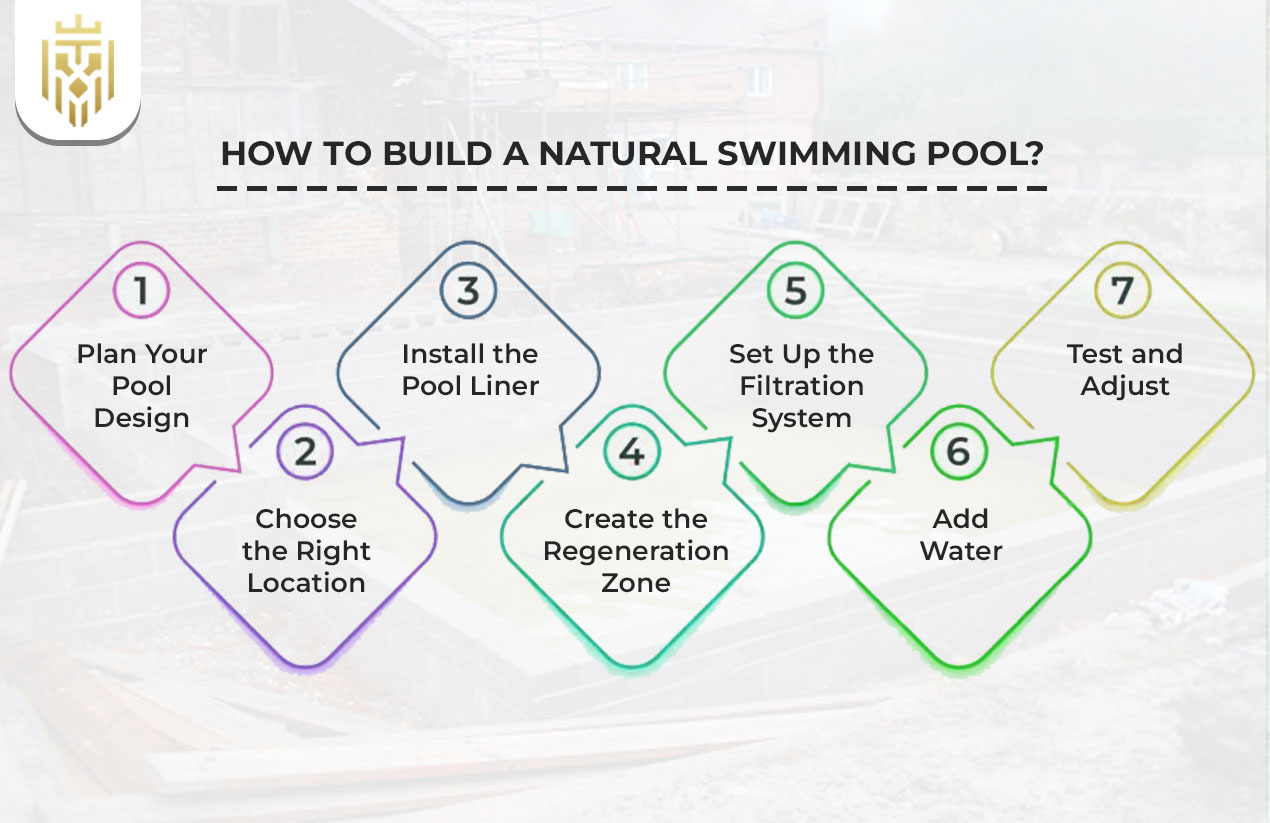
Knowledge of building a natural swimming pool naturally starts with planning fish filtration, water zones, and circulation. A natural pond swimming pool entails excavation, lining, planting, and balancing the pond water systems which shall generate a sustainable and chemical-free environment for recreational swimming.
Plan Your Pool Design
For your natural pool design, ensure clear definition of swimming and regeneration zones. Remember shape, size, and landscaping features. Waterfalls, or flowing streams, if incorporated, would boost circulation and make it look like a backyard swimming pond.
Choose the Right Location
The selection of the perfect site is conducive for the thriving of natural swimming pool. Sunny places promote plant growth, thus in areas where there are overhanging trees, a lot of debris falls to the pool. Thus location planning will contribute toward making your eco-friendly pool design function, along with adding acrues of beauty and utility to your outdoor area.
Install the Pool Liner
The installation of a liner is crucial for the construction of a natural swimming pool as liners prevent water from seeping out and soil from eroding. This holds the pond ecosystem together for the long term, keeping water in and balancing the outside environment.
Create the Regeneration Zone
The regeneration zone is filled with gravel and aquatic plants, which provide plants with filtration functions. It is the heart of a natural swimming pool and filters impurities naturally. Careful designing of this zone will ensure that clear water and balanced ecosystems are guaranteed for sustainable swimming from one year to the next.
Set Up the Filtration System
The filtration system is at the heart of a chemical-free swimming pool. The inclusion of pumps, gravel, and vegetation to set up a functioning pond ecosystem is an expression of human ingenuity. The system works naturally and continuously so that the artificial chemicals can be reduced to the absolute minimum while ensuring that the water is safe, clean, and healthy for the swimmers.
Add Water
Entering the process of filling the pool marks the beginning of the transformation of your natural swimming pool. Gradual filling is crucial because it prevents liner stress and aids plants to adjust. Activated aquatic vegetation in the regeneration zone soon becomes a vital ingredient in maintaining and sustaining the living pool while triggering processes that bring about natural water filtration.
Test and Adjust
Monitor the natural swimming pool after filling to sustain balance in it. Depending on the results of your casual tests for pH, oxygen, and transparency, apply adjustments or corrections to the natural swimming pool. This period comprises testing, making corrections, and ensuring the proper working of the eco-swimming pool design for the final product of a safe, clean, and chemical-free swimming environment.
Maintenance Tips for Natural Swimming Pools
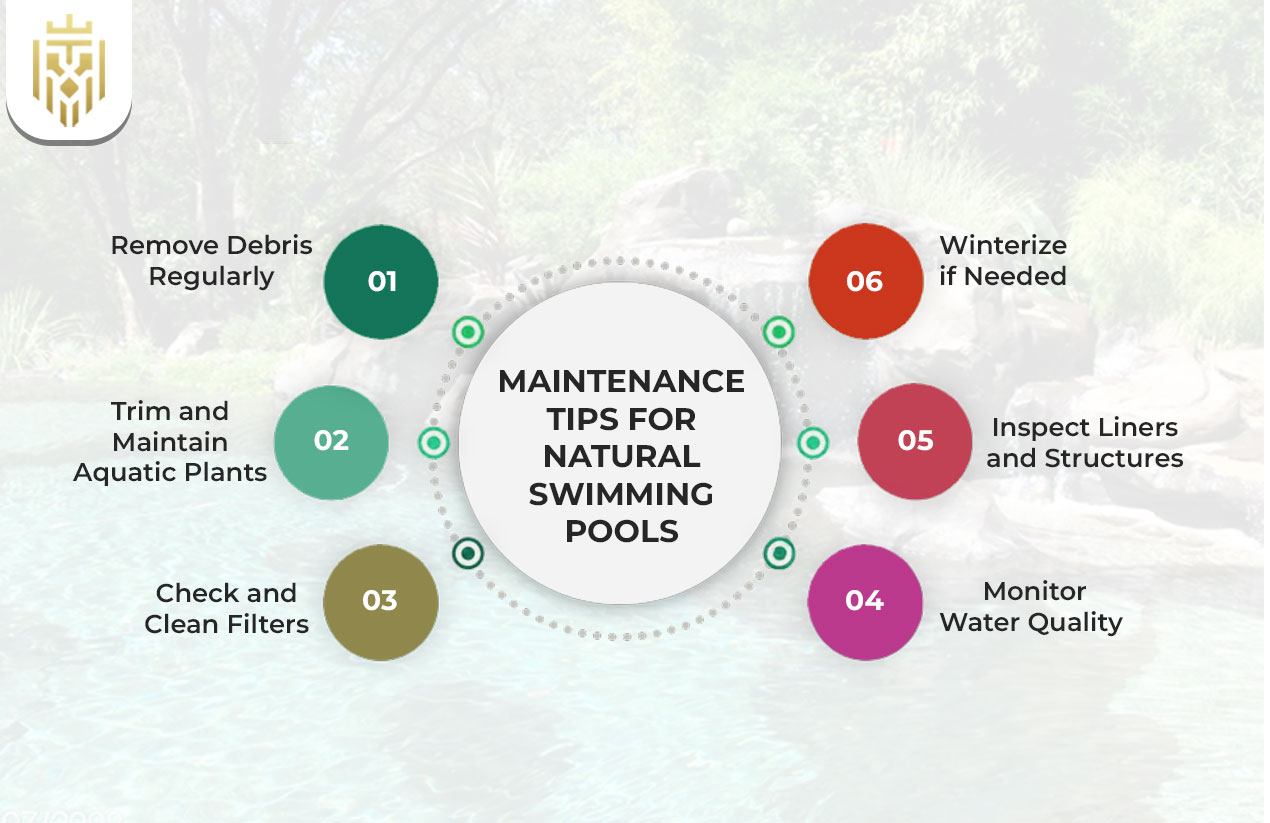
The maintenance of a natural pool requires focus on these three elements: plants, water circulation, and filtration zones. The aim is to keep maintaining the ecological balance of the pond rather than on cleaning a pool with chemicals.
Remove Debris Regularly
Keeping the natural swimming pool clean involves debris removal like leaves or twigs. Such a skimmer or net keeps organic matter from interfering with the pond ecosystem. Should this cleaning become routine, water clarity and swimmer comfort will be guaranteed through the seasons.
Trim and Maintain Aquatic Plants
Trimming aquatic plants helps with effective plant filtration and keeps the regeneration zone neat. Healthy plants are essential for a chemical-free swimming pool, as they prevent excessive algae growth. Regular maintenance ensures your natural system looks good and functions well.
Check and Clean Filters
Cleaning filters regularly keeps your eco-friendly pool design running smoothly. While plants do most of the purification, mechanical filters stop blockages. Checking the filtration parts helps maintain water circulation, extends the pool’s lifespan, and supports the natural processes that keep your living pool clear.
Monitor Water Quality
Monitoring water quality keeps your natural swimming pool safe. Test for oxygen, nutrient levels, and clarity to promote a healthy pond ecosystem. Simple changes, like adding plants or improving circulation, help protect the system’s balance and keep the pool clean and enjoyable all year.
Inspect Liners and Structures
Inspect liners and structures routinely to avoid leaks or damage in your natural swimming pool. A secure liner helps maintain the pond ecosystem’s stability. Strong structural features ensure the pool remains safe and acts as a durable, eco-friendly investment.
Winterize if Needed
In colder areas, winterizing a swimming pool is important to protect plants, liners, and systems. Draining equipment and trimming plants safeguard the eco-friendly pool design. This preparation allows the pool to wake up each spring, maintaining its beauty, function, and a balanced natural environment.
FAQs
1) What Is a Natural Swimming Pool?
A natural swimming pool is a chemical-free pool that uses plants, gravel, and natural filtration instead of chlorine. It creates a safe living pool that resembles a backyard swimming pond.
2) How to Build a Natural Swimming Pool?
To build a natural swimming pool, plan zones, install a liner, add plant filtration, and fill it with water. This forms a balanced pond ecosystem that supports sustainable, chemical-free swimming.
3) How to Design a Natural Swimming Pool?
A well-designed natural pool considers shape, depth, and a regeneration zone. Following eco-friendly design principles with aquatic plants ensures balance, beauty, and functionality for a safe, refreshing swim.
4) What are the benefits of a natural swimming pool?
A natural swimming pool provides chemical-free swimming, lower maintenance, and year-round beauty. Its eco-friendly design boosts biodiversity, creates a living pool, and turns outdoor spaces into healthy, sustainable retreats.
5) How Do natural swimming pools Work?
Natural swimming pools function through water circulation, plant filtration, and oxygenation, forming a balanced pond ecosystem. Optional skimmers or UV systems can help, but the main setup keeps the swimming water clean, safe, and chemical-free.



